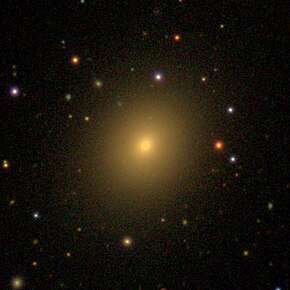| NGC 777 | |
|---|---|
 NGC 777 | |
| Observation data ( J2000 epoch) | |
| Constellation | Triangulum |
| Right ascension | 2h 00m 14.907s [1] |
| Declination | 31° 25′ 46″ [1] |
| Redshift | 0.016708 [1] |
| Heliocentric radial velocity | 5,015 km/s [2] |
| Distance | 189 million ly (58.075 mpc) [2] |
| Apparent magnitude (V) | 12 [3] |
| Characteristics | |
| Type | E1 [3] |
| Apparent size (V) | 2.5' x 2.0' [3] |
| Other designations | |
| CGCG 503-67, MCG 5-5-38, PGC 7584, UGC 1476 | |
NGC 777 is an elliptical galaxy in the constellation of Triangulum. It was discovered by William Herschel on September 12, 1784. It has a weak active nucleus of type Seyfert 2 or LINER 2, [4] implying that the central region is obscured. It may be an outlying member of galaxy cluster Abell 262. [5]
References
- ^ a b c "NGC 777". SIMBAD. Centre de données astronomiques de Strasbourg. Retrieved 2016-11-26.
- ^ a b "Results for Object NGC 0777". NASA/IPAC Extragalactic Database. Archived from the original on 2016-11-27. Retrieved 2016-11-26.
- ^ a b c "New General Catalog Objects: NGC 750 - 799". Cseligman. Retrieved 2016-11-26.
- ^ Ho, Luis C.; Filippenko, Alexei V.; Sargent, Wallace L. W. (1997). "A Search for "Dwarf" Seyfert Nuclei. III. Spectroscopic Parameters and Properties of the Host Galaxies". The Astrophysical Journal Supplement Series. 112 (2): 315–390. arXiv: astro-ph/9704107. Bibcode: 1997ApJS..112..315H. doi: 10.1086/313041. S2CID 17086638.
- ^ Faber, S. M.; et al. ( Seven Samurai) (1989). "Spectroscopy and Photometry of Elliptical Galaxies. VI. Sample Selection and Data Summary". The Astrophysical Journal Supplement Series. 69: 763–808. Bibcode: 1989ApJS...69..763F. doi: 10.1086/191327.
External links
-
 Media related to
NGC 777 at Wikimedia Commons
Media related to
NGC 777 at Wikimedia Commons
| NGC 777 | |
|---|---|
 NGC 777 | |
| Observation data ( J2000 epoch) | |
| Constellation | Triangulum |
| Right ascension | 2h 00m 14.907s [1] |
| Declination | 31° 25′ 46″ [1] |
| Redshift | 0.016708 [1] |
| Heliocentric radial velocity | 5,015 km/s [2] |
| Distance | 189 million ly (58.075 mpc) [2] |
| Apparent magnitude (V) | 12 [3] |
| Characteristics | |
| Type | E1 [3] |
| Apparent size (V) | 2.5' x 2.0' [3] |
| Other designations | |
| CGCG 503-67, MCG 5-5-38, PGC 7584, UGC 1476 | |
NGC 777 is an elliptical galaxy in the constellation of Triangulum. It was discovered by William Herschel on September 12, 1784. It has a weak active nucleus of type Seyfert 2 or LINER 2, [4] implying that the central region is obscured. It may be an outlying member of galaxy cluster Abell 262. [5]
References
- ^ a b c "NGC 777". SIMBAD. Centre de données astronomiques de Strasbourg. Retrieved 2016-11-26.
- ^ a b "Results for Object NGC 0777". NASA/IPAC Extragalactic Database. Archived from the original on 2016-11-27. Retrieved 2016-11-26.
- ^ a b c "New General Catalog Objects: NGC 750 - 799". Cseligman. Retrieved 2016-11-26.
- ^ Ho, Luis C.; Filippenko, Alexei V.; Sargent, Wallace L. W. (1997). "A Search for "Dwarf" Seyfert Nuclei. III. Spectroscopic Parameters and Properties of the Host Galaxies". The Astrophysical Journal Supplement Series. 112 (2): 315–390. arXiv: astro-ph/9704107. Bibcode: 1997ApJS..112..315H. doi: 10.1086/313041. S2CID 17086638.
- ^ Faber, S. M.; et al. ( Seven Samurai) (1989). "Spectroscopy and Photometry of Elliptical Galaxies. VI. Sample Selection and Data Summary". The Astrophysical Journal Supplement Series. 69: 763–808. Bibcode: 1989ApJS...69..763F. doi: 10.1086/191327.
External links
-
 Media related to
NGC 777 at Wikimedia Commons
Media related to
NGC 777 at Wikimedia Commons